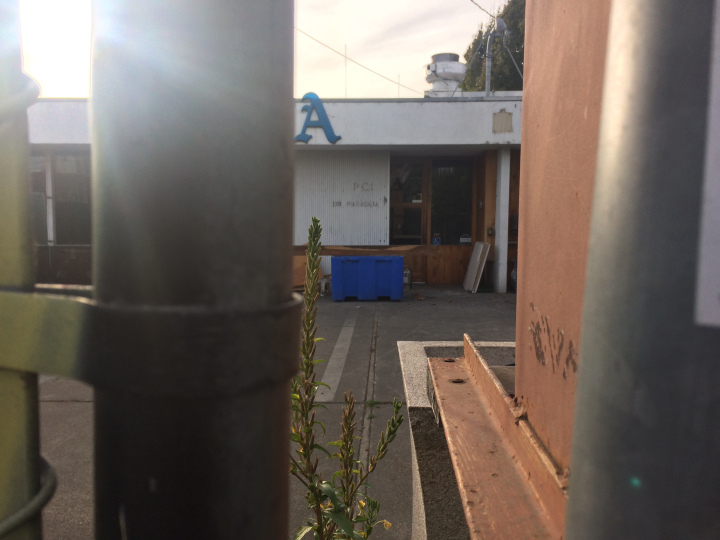Culinary Arts Programs Prep Students for a Tough Industry
By Adam Mann
Keeping a restaurant open, especially in the Bay Area, is a tall order. No fewer than 80 restaurants have closed here since December of 2016, according to Eater San Francisco. And while stiff competition amid a renaissance in the Bay Area food scene, rising commercial rent, and the poaching of qualified chefs by food delivery and other food-focused startups have all been cited as reasons for closure, one of the most formidable problems — keeping staff — comes simply as a consequence of operating in the Bay Area.

Former site of FuseBOX, a West Oakland Korean-fusion restaurant that closed in early 2017. Photo Credit: Adam Mann
Since the 2008 recession, the total cost of living has increased by around 20 percent, according to the Bay Area Consumer Price Index, and in Oakland and Berkeley, rent prices for a one bedroom apartment are up by around 70 percent over the past five years, according to Zillow rental data. As a consequence, restaurants, which operate on tight profit margins and cannot afford to pay high wages, have a difficult time holding onto workers.
“The staff situation is a nightmare,” said Hannah Hoffman in an interview with The BCC Voice. Hoffman is the former proprietor of Doughnut Dolly, a popular doughnut spot that suddenly closed its Berkeley, Oakland and San Francisco locations earlier this year. “Restaurants are having an incredible time finding staff. Everyone I know who owns a restaurant is understaffed.”
Dining establishments must compete not only for customers, but also for workers — if one restaurant doesn’t pay enough, quality staff can simply go somewhere that pays more.
One place aspiring chefs and restaurateurs look to prepare for these challenges is culinary school. Among Peralta colleges, the culinary arts program at Laney College offers two certificate programs: Baking and Pastry, and Restaurant Management. Students in these programs learn skills ranging from safety, sanitation and recipe costing, to knife skills, baking and sauces. City College of San Francisco provides a similar program, and offers free tuition for San Francisco residents.
For many, community college programs are a more sensible option than enrolling in one of the Bay Area’s dedicated culinary schools. Schools such as The Art Institute of California and San Francisco Cooking School may cost as much or more than traditional four-year colleges, and are likely to encumber students with tens of thousands of dollars of debt in an industry that is notorious for long, stress-filled hours and low starting pay. For example, attending the California Culinary Academy — which, according to the school’s website, is no longer accepting applicants — costs around $15,000 per year in tuition, and requires nearly two years of study to obtain an associate degree. At Laney College, tuition for the culinary arts program is set at $46 per unit.
At a time when restaurants are clamoring for good help, there are plenty of jobs to be had.
“If it were possible to have 200 percent employment, we would,” Chantal Martin, department co-chair of the culinary arts program at Laney College, said in an email interview with the BCC Voice.
But not all chefs agree that formal education is necessary to make it in the culinary world. Ryan Minor, former sous chef for Picán, an upscale Southern restaurant in Oakland’s Uptown that closed in mid-2017, began his career by working in a bakery when he was 14. He would wake up at 4 a.m., fry doughnuts for the shop’s morning rush, then head off to junior high. Although he attended culinary school, he is somewhat skeptical of the effectiveness of formal education in preparing students for restaurant work, calling some of the training “unrealistic.” Fresh graduates with little work experience who think they will blend in seamlessly on the job are in for a rude awakening.
“They learn recipes and stations,” Minor said, “but you sort of have to just do it. You can’t just learn from someone.”
Chantal Martin, herself a former private chef and business owner, knows that it’s more than the degree itself that gives students an advantage.
“It is very easy to find a job,” Martin said, “but the hot market will not always be hot. If you want to continue moving up, you need to show formalized education and dedication.”
In the long term, students who attain an Associate of Science degree in culinary arts are put on the path for upper management in hospitality — a position which requires a bachelor’s degree. Another important draw are the connections culinary students make among peers and faculty, which can be key to securing employment.
Still, it’s a common sentiment that in any art, there are no shortcuts. The same goes for the restaurant business.
“You are never prepared to open up your business,” Hannah Hoffman said, when asked why Doughnut Dolly closed. “Even if you think you are…the more experience you have, the more problem-solving skills you have, which, honestly, is the biggest part of doing business in the Bay Area.”
With all the obstacles facing those who choose to work in the restaurant industry, one might wonder what would drive a person to pursue such a career in the first place. “They call it culinary arts for a reason,” Chef Ryan Minor said. “It’s a passion and it drives you…sometimes a chef wants something a certain way. And it’s because he or she has an eye for something. Most people don’t grasp that.”
Read Adam Mann’s review of the student-staffed Laney Bistro here.
Advertisements Share this:





